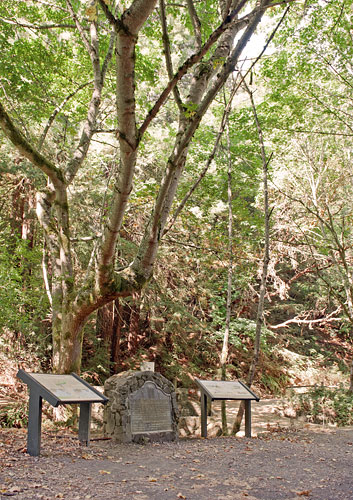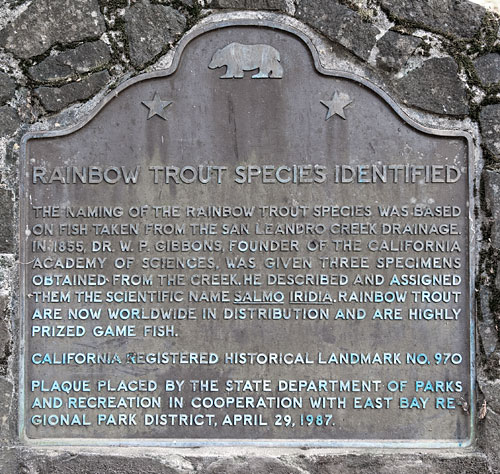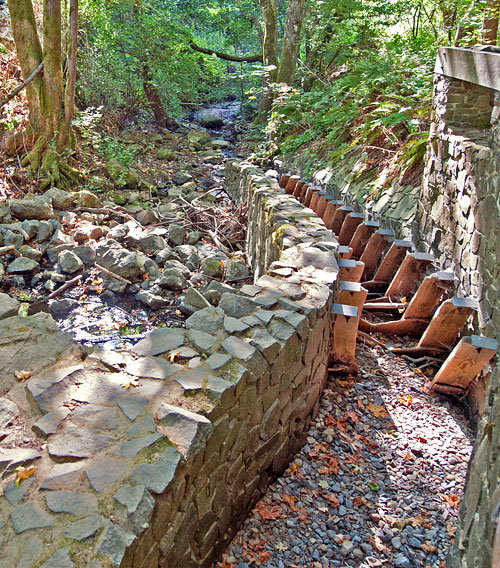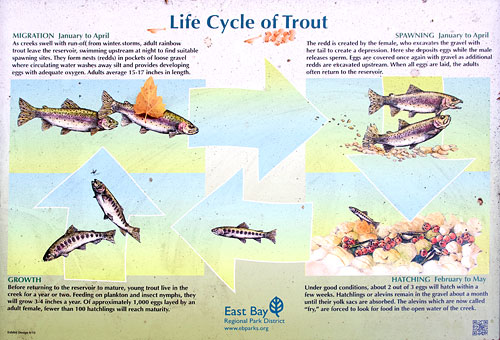California Historical Landmarks in Alameda County
California Historical Landmark 970
Rainbow Trout Species Identified
Fifty Yards Past Redwood Gate Entrance Kiosk
Redwood Regional Park
Oakland
Year - 1855


(Click Photo to Zoom)
The naming of the rainbow trout species was based on fish taken from the San Leandro Creek drainage. In 1855, Dr. W. P. Gibbons, founder of the California Academy of Sciences, was given three specimens obtained from the creek. He described and assigned them the scientific name Salmo iridia. Rainbow trout are now worldwide in distribution and are a highly prized game fish.
California Registered Historical Landmark No. 970
Plaque placed by the State Department of Parks and Recreation in cooperation with the East Bay Regional Park District, August 29, 1987.


Redwood Creek is a tributary of San Leandro Creek.
8 September 2012
(Click Photo to Zoom)
For a number of years this roadway crossing formed a barrier to rainbow trout at a midpoint in their migration to spawning areas upstream.
In 1983, park crews completed this Denil Fishway which incorporates wooden baffles designed to slow the velocity of the stream current. This design enables trout to swim up the five foot elevation with relative ease. Now migrating trout are able to spawn two miles farther upstream.


(Click Photo to Zoom)
Migration: January to April
As creeks swell with run-off from winter storms, adult rainbow trout leave the reservoir, swimming upstream at night to find suitable spawning sites. They form nests (redds) in pockets of loose gravel where circulating water washes away silt and provides developing eggs with adequate oxygen. Adults average 15-17 inches long.
Spawning: January to April
The redd is created by the female, who excavates the gravel with her tail to create a depression. Here she deposits eggs while the male releases sperm. Eggs are covered once again with gravel as additional redds are excavated upstream. When all eggs are laid, the adults often return to the reservoir.
Hatching: February to May
Under good conditions, about 2 out of 3 eggs will hatch within a few weeks. Hatchlings or alevins remain in the gravel for about a month until their yolk sacs are absorbed. The alevins which are now called "fry," are forced to look for food in the open water of the creek.
Growth
Before returning to the reservoir to mature, young trout live in the creek for a year or two. Feeding on plankton and insect nymphs, they will
grow 3-4 inches a year. Of approximately 1,000 eggs layed [sic] by an adult female, fewer than 100 hatchlings will reach maturity.


(Click Photo to Zoom)
Stream Restoration
Park District staff is working to restore Redwood Creek as a viable and healthy wildlife habitat. Foot traffic, dogs, and bicycles have caused serious erosion along the banks of Redwood Creek. Erosion causes poor water quality and pool sedimentation that destroys the ability of the habitat to support newts, fish and other aquatic creatures.
District staff erected a split-rail fence and placed a series of interpretive panels to help visitors understand the value of wild stream corridors.
You can help us by staying on the trail and not going down to the creek. Keep your dogs on a leash and out of the stream.
The accumulation of leaves and branches is helping maintain soil moisture and provide a seed bed for new ferns and shrubs. Quietly and slowly, the stream is returning to its original condition, flanked by luxurious banks of vegetation. Native rainbow trout and California newts will continue to use this critical habitat to reproduce and hopefully increase in numbers.